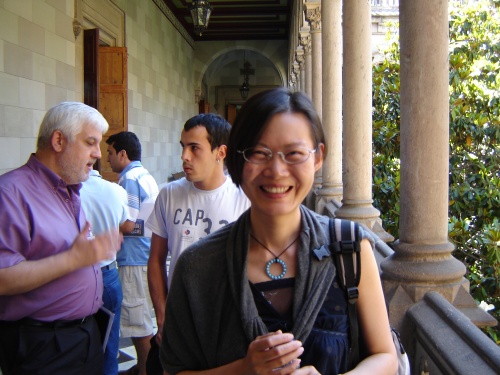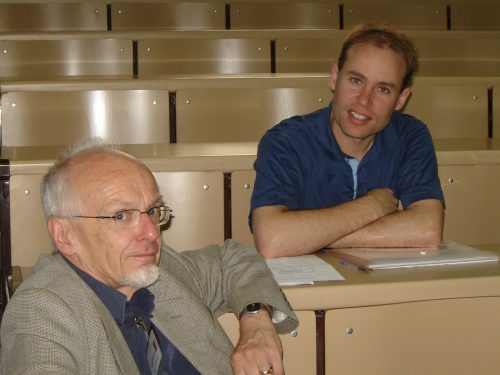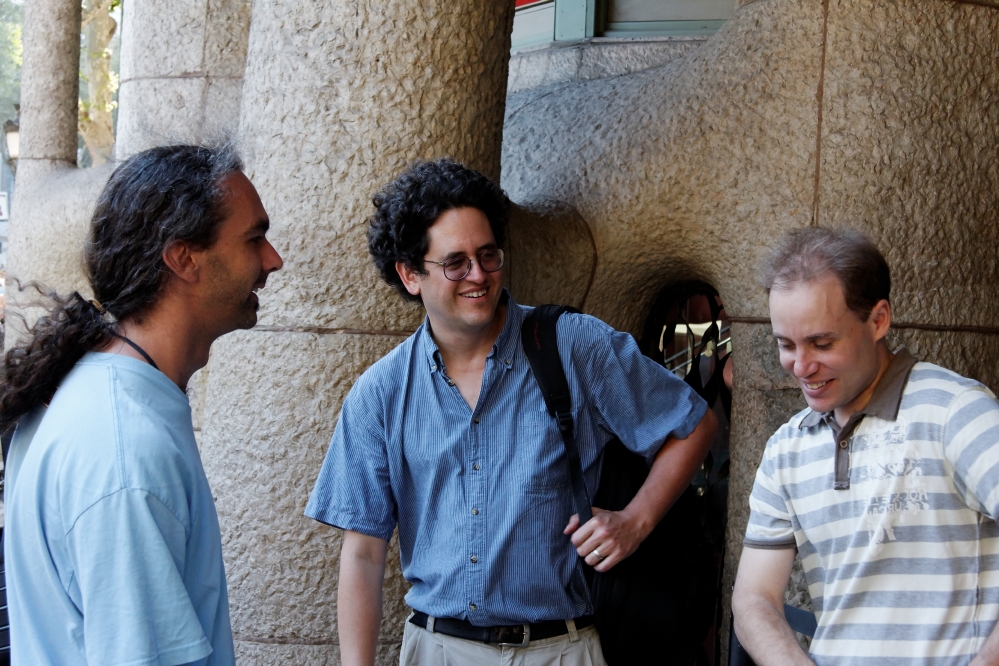Now that I’ve stopped going to conferences I finally have time for some addenda to “week266”:
First, the slides for Aurora del Río’s nice talk are — as for many of the talks —- now
available from the website of the Barcelona categorical group workshop:
25) Aurora del Río, Algebraic K-theory for categorical groups,
http://mat.uab.cat/~kock/crm/hocat/cat-groups/slides/delRio.pdf
I also found a link to the paper she and Antonio Garzón wrote on this topic:
26) Antonio Garzón and Aurora del Río,
On algebraic K-theory categorical groups,
http://www.ugr.es/~agarzon/K-thCG.pdf
Second, Bruce Bartlett pointed out that to get something equivalent to the category of representations of a finite group G, he
doesn’t require that his manifolds be Kähler: it’s enough that
they be complex manifolds equipped with a Riemann metric. Personally I greatly prefer Kähler manifolds, so I hope it’s enough to use those!
Third, writing “week266” caused me to miss Behrang Noohi’s talk on using diagrams called “butterflies” to efficiently describe weak homomorphisms between strict 2-groups (in the guise of crossed modules). Bad move! Luckily Tim Porter summarized it here at the n-Category Café:
27) Timothy Porter, Behrang Noohi on butterflies and weak morphisms
between 2-groups, available at
http://golem.ph.utexas.edu/category/2008/06/behrang_noohi_on_butterflies_a.html
For more details, you can’t beat the original paper:
28) Behrang Noohi, On weak maps between 2-groups, available as
arXiv:math/0506313.
Also here at the n-Category Café, Bruce Bartlett discussed Tim Porter’s talk at the categorical groups workshop:
29) Bruce Bartlett, Tim Porter on formal homotopy quantum field
theories and 2-groups, available at http://golem.ph.utexas.edu/category/2008/06/tim_porter_on_formal_homotopy.html
Actually Porter gave two talks. The first was an introduction to
simplicial methods and crossed complexes, but Bartlett didn’t
summarize that, and no slides are available.
So for that, you should get ahold of the following
free book:
30) Timothy Porter, The Crossed Menagerie: an Introduction to
Crossed Gadgetry and Cohomology in Algebra and Topology, available
at http://www.informatics.bangor.ac.uk/~tporter/menagerie.pdf
and (harder) this review article highly recommended by Porter:
31) E. Curtis, Simplicial homotopy theory, Adv. Math. 6 (1971), 107-209.
The second talk by Porter, the one Bartlett blogged about, can be
found at the workshop’s website:
32) Timothy Porter, Formal homotopy quantum field theories and
2-groups, available at http://mat.uab.cat/~kock/crm/hocat/cat-groups/slides/Porter.pdf
This talk covered the papers by Martins, Porter and Turaev mentioned in “week266”.
I apologize to everyone whose talks I still have not mentioned!
Finally, just for fun, here are a few photos from the workshop:

Chenchang Zhu, with Carles Cascabuerta talking to student
in background

Timothy Porter and Bruce Bartlett

Aurora del Río, Alain Rousseau, Pilar Carrasco and André Joyal
(photo by Tim Porter)

Derek Wise, John Baez and Bruce Bartlett
(photo by Mathieu Anel)






Re: This Week’s Finds in Mathematical Physics (Week 266)
It is not difficult to use an octahedron as a spinning top. It “floats” like air. I did it with an 8-sided dice while playing RPG.
Maybe old greek children liked to play with spinning tops?
Kylix of Hermes and Youth Spinning Top
c. 480-470 B.C.E
Baltimore, The Johns Hopkins University, Archaeological Collection, B9
Ex Collection Hartwig, Rome
In Coming of Age in Ancient Greece, cat. 16
On this red-figure kylix, the painter Douris shows Hermes teaching a youth how to spin a top. Hermes (left) is not shown here with the kerykeion, the traditional wand, so it is a bit difficult to identify him for certain, but this image does resemble several in which he is shown with his traditional attribute.
As Hermes served the patron deity of the gymnasium, he was thought to have a particularly close association with young boys and was said to have invented the spinning top. Accordingly, many Greek male youth brought tops and other toys to sanctuaries to be dedicated to Hermes when they came of age and it became time for them to lay away these childish things.